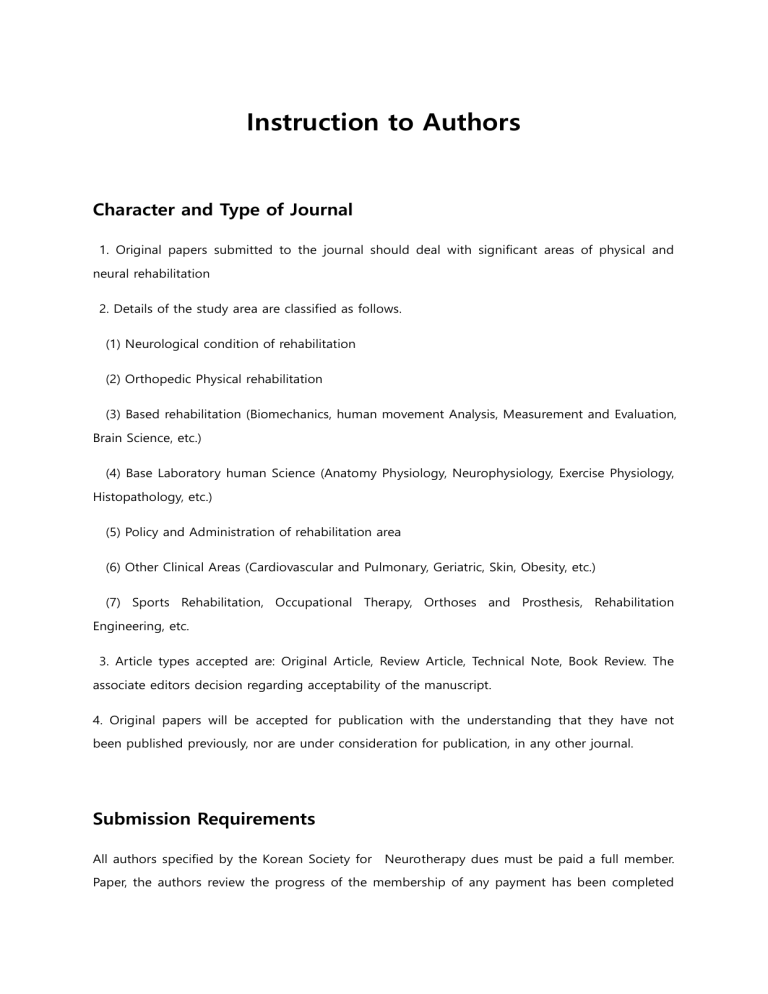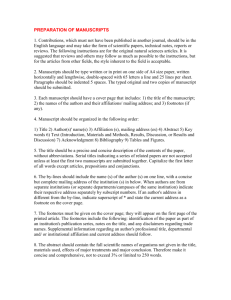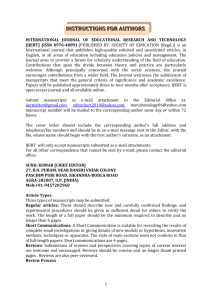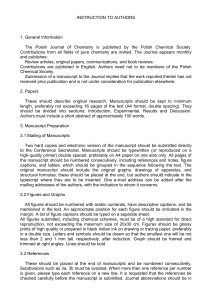Instruction to Authors Character and Type of Journal

Instruction to Authors
Character and Type of Journal
1. Original papers submitted to the journal should deal with significant areas of physical and neural rehabilitation
2. Details of the study area are classified as follows.
(1) Neurological condition of rehabilitation
(2) Orthopedic Physical rehabilitation
(3) Based rehabilitation (Biomechanics, human movement Analysis, Measurement and Evaluation,
Brain Science, etc.)
(4) Base Laboratory human Science (Anatomy Physiology, Neurophysiology, Exercise Physiology,
Histopathology, etc.)
(5) Policy and Administration of rehabilitation area
(6) Other Clinical Areas (Cardiovascular and Pulmonary, Geriatric, Skin, Obesity, etc.)
(7) Sports Rehabilitation, Occupational Therapy, Orthoses and Prosthesis, Rehabilitation
Engineering, etc.
3. Article types accepted are: Original Article, Review Article, Technical Note, Book Review. The associate editors decision regarding acceptability of the manuscript.
4. Original papers will be accepted for publication with the understanding that they have not been published previously, nor are under consideration for publication, in any other journal.
Submission Requirements
All authors specified by the Korean Society for Neurotherapy dues must be paid a full member.
Paper, the authors review the progress of the membership of any payment has been completed
and if begins.
Language
1. Should be written in Korean or English. Translation of medical terminology based on the use of a new term rehabilitation medicine and medical science textbook glossary of term is used.
Other terms of the Medical Association 2001 revised fourth edition shall be subject in the revised medical terminology.
2. When writing Korean papers if you do not have proper translations of medical terminology, proper nouns, sports, treatment and test methods, units, etc. are used as original language.
3. With translations, but the meaning is not clear if the term is used as the first translations in parentheses in the original language is indicated by the following. Only translations is used thereafter. On terms that are commonly used in English notation should be avoided.
4. When writing English papers, English abbreviations used to minimize. Initially used as the source language and then use the abbreviation in parentheses. After only abbreviations is used.
Examination of Journal
Authors of submitted manuscripts may recommend three qualified reviewers who are not members of their institutions and who are not collaborators. Reviewers comments and the associate editors decision regarding acceptability of the manuscript. Authors are generally required to revise their manuscript before formal acceptance of the paper for publication.
Content of Manuscripts
1. Abstract: Outlining the Purpose, Methods, Results, and Conclusion of the paper. All publications will be in English, not exceeding 250 words and key words.
2. Introduction: Include a list a background review of the experimental design of your study and the measurement techniques used, citing salient literature. Conclude with the hypothesis in
involved and/or the purpose of the investigation and how it will address deficiencies in existing knowledge.
3. Materials and Methods: Enough detail must be given in Materials and Methods so that others may repeat your work. Identify the number of times individual experimental treatments and the number of times individual experiments were duplicated. For standard methods, describe in adequate detail those procedures that have not been fully described in cited publications. List model number and sources of equipment and media. Include statistical analysis.
4. Results: Report the results of your study here; reserve your interpretation of the results for the discussion section. Present results concisely in the text and any accompanying tables and figures, if necessary. Avoid extensive use of graphs; tables are often more effective.
5. Discussion: The purpose of this section is to interpret the results in relation to previous literature, to proposed explanations for the results observed, and to discuss possible applications.
Avoid speculation unsupported by the data obtained.
Notes on Review and Case Report
1. Review: The science editor assigns each manuscript to an associate editor, who will be identified to the author.
2. Case Report:
(1) Abstract: All publications will be in English, not exceeding 200 words. Unlike original papers does not separate section should be written in one paragraph. Include a list a background review of your study and the observations are described only briefly.
(2) Introduction: Generally associated with a case briefly describes the background and significance.
(3) Case Report: Concise and directly related to a case described only in part.
(4) Discussion: To highlight a case of focusing on parts, tedious literature should be avoided.
(5) References: reference (down to 15)
Author Checklist
Manuscripts should comply with the following provisions. If incongruity manuscripts on guidelines send back, and in this case, the manuscript must be received by modifying the back.
Formatting
Please note the required content of the whole file and the required order of that content.
1. A title page with names and contact details for all authors
2. A structured abstract of no more than 250 words
3. The text (usually Introduction, Material and Methods, Results, Discussion)
4. References (Vancouver style)
5. Tables, each starting on a new page
6. Figures, each starting on a new page
7. Appendix (if any)
8. A title and details in the captions of graphs, tables, and figures, and these must be written in
English for both Korean and English journals
1. General Information
(1) Manuscripts should use MS word or HWP, certainly that was written to provide manuscripts form by Korean Society for Neurotherapy website.
(2) Editing the paper: A4 paper is used to download the manuscripts form, use the default values.
(3) If contribute the article written in English was present an English sentence reform certification.
Manuscripts must be typed with 25-mm margins on both sides using 10-point type in Times New
Roman font on A4-size (210 × 297 mm) paper. All lines of the text should be numbered serially in the left margin, and the entire manuscript should be paginated. The text should be divided into captioned sections, such as Introduction, Material and Methods, Results, Discussion. All
manuscripts should go through English proofreading before submission and the manuscript should be submitted with a certificate upon request. Tables should be created by Microsoft
Excel® or Microsoft Word® and saved with extention “.xls” or “.doc” before submission. (Tables created by Microsoft PowerPoint® will not be accepted.)
2. Cover
(1) Title of manuscripts was described Korean and English title. Korean title was described within
30 characters, English title was described within 20 words.
(2) With subtitles, of wood at the end with a colon (:) after displaying the subtitles are described.
(3) English title was described capitalize letters every word except article, preposition and conjunction. If the primary word was article, primary characters of article described to capitalize, and describing a case with subtitles, of wood at the end with a colon (:) after displaying the first letter of first word capitalized, and the rest is all lowercase.
(4) Number of pages, number of tables, figure number, the number of references to be described.
3. Authors Information and Paper Appearing Agreement
(1) Author's names and affiliations
Present the authors' affiliation addresses (where the actual work was done) below the names.
Indicate all affiliations with a lower-case superscript letter immediately after the author's name and in front of the appropriate address. Provide the full postal address of each affiliation.
(2) Corresponding author
Clearly indicate who is willing to handle correspondence at all stages of refereeing and publication, also postpublication. Ensure that telephone and fax numbers are provided in addition to the e-mail address and the complete postal address.
(3) Before the accepted manuscript is published in an online issue.
Requests to add or remove an author, or to rearrange the author names, must be sent to the
Journal Manager from the corresponding author of the accepted manuscript and must include: (a) the reason the name should be added or removed, or the author names rearranged and (b) written confirmation (e-mail, fax, letter) from all authors that they agreed with the addition,
removal or rearrangement. In the case of addition or removal of authors, this includes confirmation from the author being added or removed. Requests that are not sent by the corresponding author will be forwarded by the Journal Manager to the corresponding author, who must follow the procedure as described above. Note that: ич Journal Managers will inform the
Journal Editors of any such requests and иш publication of the accepted manuscript in an online issue is suspended until authorship has been agreed.
4. Abstract
Abstract should be written in English and should give readers a short, concise of your Purpose,
Methods, Results, and Conclusion, not exceeding 250 words. Also any abbreviations or references are strongly discouraged. Readers of your abstract will sometimes not read the paper as a whole, at least three keywords are strongly encouraged in order to give them an overall pictures of your work.
Ethics and Informed consent
All manuscripts reporting on randomized controlled trials must include a statement that the authors received approval from a properly constituted ethics committee and the authors should specify that written informed consent has been obtained from each subject or patient. In the manuscript, authors should provide the name of the institutional review board (IRB), or other similar body that approved the study. Studies on human subjects should comply with the ethical standards of the Declaration of Helsinki (1975, revised 1983).
5. Text
(1) Font and paragraph form will accept the downloaded paper form.
(2) Manuscript is in the following order: Introduction, Methods, Results, Discussion, References, tables, figure and figure description.
(3) Step number of text: 1., 1), йч, ич should be in order.
(4) Description of the equipment used in research on the text is described as follows.
- Used equipment (Equipment name, manufacturer, country)
- Equipment name and manufacturer in accordance with the manufacturer's notation can be displayed in English and Koreans or country should be listed in Koreans.
(5) Study subjects for the experiment in the way of acceptance must be included (except animals).
(6) general method cited
• If your citation one: ... It was reported to be .1
• If you have two citations: ... It was reported to be .1,3
• If more than three citations: ... It was reported that .1,3,4
• 3 or more consecutive citations: The report that was ... .1,3-5,7
- When describing a person's name
• If the author who is a: Kim1, Duncan1 is ...
• If the author who is 2: Hwang and Lee3 are, Seitz and Rossini4 are
• If more than three authors: Park et al5, Katz et al6 without inserting tables and figures in the text of references should be written in a separate page at the back. The position of tables and figures in the text should be listed as follows.
• Displays the results were found (Table 1) (Table 1, 2) (Table 1, Figure 2).
• Results showed (Figure 1) (Figure 1, 2) (Figure 1A) (Figure 1A, 1B)
(7) At screening, if cited literature is not detected, the editorial board may be requested the author on relevant reference.
6. References(Vancouver style)
(1) Reference numbers have full points in the reference list.
(2) Please ensure that publications are referenced in the order in which they appear in the text.
(3) Journal titles should be abbreviated according to the standard in the Index Medicus. If unsure, please check for any inconsistencies within reference lists. For STM journals, please refer also to the following: http://scieng.library.ubc.ca/coden/.
(4) Do not separate initials with spaces or full points, but add a full point after last initial before
the title.
(5) Up to three authors may be listed. If more, then list the first three authors and represent the rest by et al. Fewer author names followed by et al. is also acceptable. Where et al. is used, it should always be upright, not italic in both references and textual citations.
- References must be written to only citations in the text.
- Indicate references to the literature in the text by Arabic numerals that consecutively through the paper in order of their appearance, and the number of references should be limited not more than 15 units and less than 40.
- Write down all of last name of the author, and attaching the initials of first and middle name is written by capital letters. National literatures also must be written in English.
- Cited references should be more than 30% in the literatures within the last 5 years.
- Title of journal is written according to abbreviation of Index Medicus. If not have Index
Medicus, to fill in an the whole title of journal.
- In article title or book title of reference, the first letter should be written by capital letter, the rest is written by small letter. The example follows.
For a regular journal, reference consist of the author's name, title of paper, title of journal, year of publication of journal, volume of journal, number of issue, and first and last page numbers of the paper. The number of the author is if less than three people write in all, and if more than four write until three authors. The others followed by "et al".
For example:
1. Behrman AK, Lawless-Dixon AR, Davis SB et al. Locomotor training progression and outcomes after incomplete spinal cord injury. Phys Ther. 2005;85(12):1356-71.
2. Ory M, Resnick B, Jordan PJ et al. Screening, safety, and adverse events in physical activity interventions: collaborative experiences from the behavior change consortium. Ann Behav Med.
2005;Suppl:20-8.
For a book, reference consist of order of the author's name, title of book, number of edition (first edition is not list), place of publication, publisher's name, year of publication of journal, and first and last page numbers of book.
3. Kitchen S. Electrotherapy: Evidence-based practice. 11th ed. New York, Churchill Livingstone,
2002:165-186.
4. Mark S, Williams T. Review of physical therapy. In: Johnson HS, eds. Exercise and Physiology:
Incidence of disease. New York, Churchill Livingstone, 1996:789-810.
5. Hong GD. Ipsilateral movement deficits of upper extremity in stroke. Daehan University.
Dissertation of Master's Degree. 2002.
6. Hong GD. Ipsilateral movement deficits of upper extremity in stroke. Daehan University.
Dissertation of Doctorate Degree. 2002.
Please use numbers in parentheses after the punctuation, and check that it corresponds to the correct number in the reference list.
Textual Notes and footnotes
References: Vancouver style reference citations are represented as textual notes, as a numeral enclosed in parentheses .
Abbreviations
(1) .Abbreviations that are used only in tables, appendices, or figures should be defined in the table, appendix, or figure legend. All abbreviations must be defined upon first mention in the body of the manuscript.
(2). Do not use abbreviations in the title of a paper, in the abstract, or keywords, unless the full version is very long and clumsy or the abbreviation is better known than the full term (e.g. DNA).
Abbreviations may be used in headings and subheadings if they has already been defined previously in the paper at first usage. If in doubt, spell out.
(3) Define an abbreviation the first time that it is used (except in the Abstract): write the term out in full followed by the abbreviation in parentheses. Use the abbreviation consistently thereafter, including at the start of sentences.
(4) For plural terms, use plural abbreviations.
(5) If you need to abbreviate months or days of the week (for example, in a crowded table), use the first three letters without a full-stop (Mon, Tue; Jan, Feb).
(6) If abbreviations are used in a figure or table, they must all be defined in the caption or in a
Table note/footnote even if they are also defined in the text.
(7) Do not use abbreviations invented by the author of a paper for that paper – ideally, only conventional, generally accepted abbreviations should be used.
7. Acknowledgements: Write if necessary.
8. Table and Figure
Table
(1) Tables do not need to be a full column width or page width, but should be the appropriate width for the content.
(2) Table headings should be left aligned, even when they relate to multiple columns, unless this creates confusion.
(3) Tables should only have minimal horizontal rules for clarity, and no vertical rules.
(4) All tables should be numbered consecutively and cited in the text as Table 1, Table 2 etc.
(Table should be spelled out in full, not abbreviated).
(5) Table permissions: any tables reproduced from another publication need permission. In cases where those publishers listed on the STM permission Guidelines page ().
(6) Source: in cases where permission is required and has been obtained, this should appear below the table in the following form: Source: reproduced with permission from publisher, year, reference number (Vancouver), author, date (Harvard).
(7) General notes to the Table should be positioned below the Table, typeset in a smaller font and should start ‘Note:’, and end in a full stop. Do not add the word ‘Note:’ unless needed for clarity.
(8) Footnotes should be represented in the table by superscript letters a, b, c, etc., and appear below the Table (smaller font, TS will format). Each footnote should start a new line and end with a full stop. These notes should precede the source for the table, if included.
(9) Captions are positioned above the table and left aligned with 9-font.
(10) Normal text in columns should always be left aligned. Data in tables should be aligned on
units if all the data in that column take the same units. Otherwise, the data should be left aligned.
Units in table headings should be enclosed by parentheses, not square brackets (if any brackets are required at all).
(11) Title of journal is written according to abbreviation of Index Medicus. If not have Index
Medicus, to fill in an the whole title of journal.
Figures
(1) STM: All figures should have a key line (i.e. be enclosed in a box).
(2) Figures should be appropriately sized. They do not need to be a full column width or page width.
(3) Figure permissions: any figures reproduced from another publication need permission. In cases where those publishers listed on the STM permission Guidelines page (http://www.stmassoc.org/permissions-guidelines/).
(4) Source: in cases where permission is required and has been obtained, this should appear below the caption in the following form: Source: reproduced with permission from publisher, year, reference number (Vancouver), author, date (Harvard).
(5) Any abbreviations needing to be spelled out should be listed after the caption, starting on the next line, in the following format: IC: internal combustion; PID: proportional–integral– derivative).
(6) Captions are positioned below the figures and left aligned.
(7) Where figures have multiple parts, these should be labelled as (a), (b), (c), etc. (not A, B, C).
Captions should contain subheadings for all parts if not present in the figure itself.
(8) All figures should be numbered consecutively and cited in the text as Figure 1, Figure 2 etc.
(Figure should be spelled out in full, not abbreviated).
(9) Figures should be in black ink on heavy white paper with special attention paid to clarity. A separate sheet of paper should be used for each figure legend.
(10) The storage type of a figure is jpg, gif, tif, etc, and printing must be in good condition.
(11) When publish paper, figure is grey color, but if you want to color figure, additional cost shall
be borne by the author.
(12) Text citations: figures should be referenced in the text as follows: Figure 1, or Figures 1 and
2, or Figures 2 to 4, or Figure 1(a) and (b), or Figure 2(a) to (c). Where the figure citation is not part of the sentence it should be placed in parentheses.
- Number of table and figure should be limited to five.
- All tables and figures should be written in English and is fitted with a serial number. Internal formula of tables and figures will be able to use English abbreviation and explanation of abbreviation should be illustrate at bottom of table or figure. e.g.) If the abbreviation in table is PT, at the bottom of table is written in PT: physical therapy. Otherwise explanation is used in order the following codes (e.g., *p<0.05)
- The title of table and figure clearly describes the form as clause or phrase, and the first letter of sentence is written in capital letter. Write the title at the top of the table and a explanation for the table is described at the bottom. When making a table, thickness of line use the default value and do not use vertical line.
- In the content of table and figure, the content of the text not will be list duplicate.
- Illustration for the figure make written statement in order to enough to understand without text, and the first letter of sentence is written in capital letter.
- You should be to mark the points of emphasis by using the arrow etc so that the content of figure and picture can be easily understood. Record the method of staining and proportion in photomicrograph.
- The capacity of the entire paper, including figure, shall not exceed 5 megabyte.
Copyright
The copyright of published paper belongs to The Journal of Korean Society for Neurotherapy.






